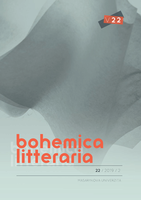Časopis Kritische Blätter für Literatur und Kunst (1857–1858) v kontextu soudobých literárněkritických debat o realismu
The Kritische Blätter für Literatur und Kunst Journal (1857–1858) in the context of the contemporary debates on Realism and the shape of literary criticism
Author(s): Zuzana UrválkováSubject(s): Language and Literature Studies, Studies of Literature, Czech Literature
Published by: Masarykova univerzita nakladatelství
Keywords: Kritische Blätter für Literatur und Kunst; literary journals; literary criticism; the 1850s; ideal realism; Eduard Schmidt-Weissenfels; Julian Schmidt; Ignác Jan Hanuš; Czech-German Literary Relations
Summary/Abstract: This paper presents the age of literary criticism in German-language journals, as mapped out by Kritische Blätter für Literatur und Kunst (1857–1858), which was published in Prague and Leipzig by the Czech publisher Ignác Leopold Kober. The journal took part in the disputes that had taken place in the German literary criticism, concerning the form of Realism in art, and became a focal point where rationally defined, objective criticism was cultivated in the spirit of Enlightenment. While its editor, the German Eduard Schmidt-Weissenfels, in his articles presented a sort of an ideal Realism, which he further specified and favoured instead of the documentary, or "absolute" Realism (the equivalent of which in today's theory of literature would be Naturalism), the Czech Ignác Jan Hanuš promoted the critical evaluation of Slavic and Hungarian academic works in addition to those written in German. The Czech-German editorship with its supranational and panaustrian approach strived to create an organ of literary criticism to reflect the science and arts of the cultural space of Central Europe without the limitations of national standpoints. While Schmidt-Weissenfels pointed to Idealism and Romanticism in his programme of Ideal Realism, Hanuš and his collaborators (namely Julius Feifalík) pointed a critical mirror toward the Romantic tradition in Czech literary science by questioning the authenticity of the oldest literary monuments in Czech and the results of Czech literary science, using both the method of rational criticism and German science's strict measures. Kritische Blätter für Literatur und Kunst (1857–1858) provided the impulse for the response of the Czech post-March criticism, as well – authors such as Jan Neruda and Karel Sabina started promoting Realism and defining its aesthetic framework.
Journal: Bohemica litteraria
- Issue Year: 22/2019
- Issue No: 2
- Page Range: 58-80
- Page Count: 23
- Language: Czech

